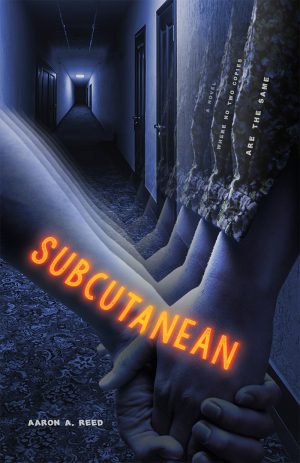
Most of my first-Tuesday-of-the-month posts cover books about craft, writing, or game design in some way. This is an exception, though: recently I had a chance to read Aaron Reed’s horror novel Subcutanean. It tells the story of a young man who discovers his basement is much larger, deeper, stranger, and more branching than any basement has a right to be. It’s also written with a generative text process that means no two copies are alike.
As a premise, “basement is bigger than it should be” might not seem to be that horrifying. But in this case, it genuinely is. I don’t want to spoil the story, but I was surprised at how effectively Aaron made what might seem a fairly passive menace into something really threatening.
From about a third of the way into the book, I was hooked in a way that rarely happens to me these days — that kind of MUST READ NEXT PAGE attention that makes you put off going to get a glass of water for two or three hours on end because the spell just hasn’t broken yet.
I also found it interesting as a project in novel-length generative text. It’s different from a lot of generative projects in that it feels human-written from end to end. There is no point where I found myself thinking, “oh yes, this was made by a grammar.” That’s because it largely is human-written, and then machine-elaborated, or machine-varied. The alternate forms of a sentence are all things that Aaron explicitly planned for; it’s the combinations of forms that he might not have anticipated.
At which point, you might think, well, why do a generative text at all? If it doesn’t feel like it was made by a machine in some way (and I’ve talked about the aesthetics of intentionally mechanical-feeling text), and if it doesn’t need to be instantly generated or arbitrarily long, then what is the point?
The point, at least in Subcutanean, is the divergence. My copy isn’t your copy; it’s different in all sorts of ways; and that chimes with the core conceit of the story. This is a novel about the unknowable proliferation of motives and outcomes; about the fact that the same set of events might have many different interpersonal explanations, or lead to many different consequences; that the same people might follow dissimilar trajectories.
At the end of the copy I read, there is a page that describes differences between my Subcutanean and some other versions. Some of those differences were significant, suggesting major plot points that could have gone another way. When I finished my version of the book, I was immediately curious to try other variants, to try to get a sense of what the whole plot possibility space would look like. But even if I ordered another copy, or two copies, or more, I’d never fully map that potential space. Knowing the story’s territory cannot be completely mapped brings a provocative uncertainty into the realm of static text that I generally associate only with interactive stories. Which is a perfect for the book’s themes.
I’ve recently become an Aaron Reed fan and put together some of the pieces of who he is (wrote Blue Lacuna, wrote THE Inform 7 book, run Spring Thing now, etc.). I read a VERY large portion of the Blue Lacuna source code and found many delights and learning there. So, I was excited when I saw your review of his generative book, so thanks for finding the time to read it and give your thoughts.
I obtained two copies and read them both in an evening, and they felt satisfyingly different-yet-similar. The tone of the story was very different, with narrators who only superficially resembled each other. I feel like I read them in the best order; the second was much more hopeful and optimistic.
Funnily enough in the first one I read, I had one section of text (about three or four paragraphs) which appeared in two separate places, which felt very procedural-generation-hiccup. :D
The first one’s ‘how this differs from other copies’ was interesting in a mild way in what it said could be different. The second one’s ‘how this differs from other copies’ was utterly FASCINATING in the hints at how far the story could diverge. I would love to see a copy that really wildly differs from my own.